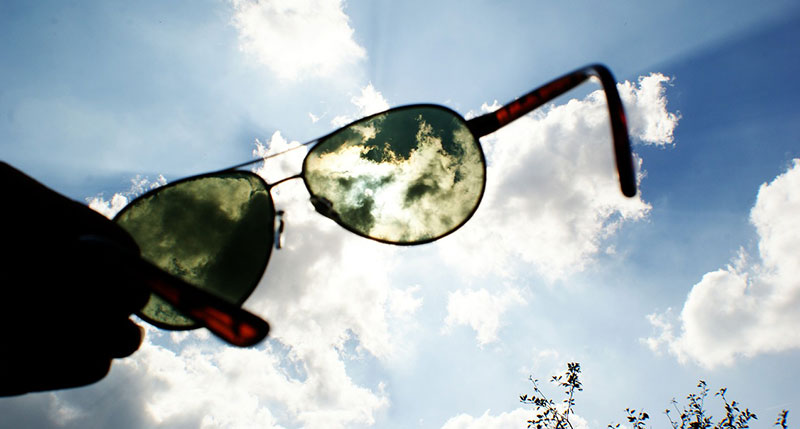July is UV Safety Month. In our optometry practice, eye safety is always top-of-mind. Did you know that the sun’s harmful rays can damage your eyes if you don’t protect them?
You slather on the sunscreen to protect your skin from sunburn before you go outside, right? In addition, you need to protect your eyes—and those of your children and loved ones―with a high-quality pair of sunglasses that block 100% of the sun’s ultraviolet rays.
Here are 10 fun facts about sunglasses:
- The term “sunglasses” isn’t correct—at least, not anymore. While the lenses of sunglasses were once made from glass, today’s high-performance plastic lenses add various improvements, including lighter weight and shatterproof lenses. However, “sunplastics” just doesn’t sound as cool, so let’s keep calling them sunglasses.
- Sunglasses have history … They were first seen around 2,000 years ago in a very snowy climate. The Inuit Eskimos fashioned crude snow goggles from animal bone, wood and leather. The resulting eye covers featured small slits that they could see through—and which minimized the blinding glare of the sun’s rays reflecting off the snow.
- … A long history! Roman Emperor Nero, around 50 CE, reportedly wore polished emeralds to watch the epic Gladiator fights in the colosseum. This helped him see more comfortably on sunny days under the bright Mediterranean sun!
- Who’s behind those Foster Grants? The first “modern” sunglasses were Foster Grants. They were sold in 1929 in Atlantic City, NJ, by Sam Foster, who initially went into business to make combs. He soon found out that his sunglasses were far more popular than combs!
- Eyebrows or not? What do you think: Should eyebrows be visible above the top of your sunglasses, or should sunglasses hide them? It’s an ongoing debate in the sunglasses world. It likely depends on your face shape and personal preference. But The Great Eyebrow Debate continues without a definitive conclusion.
- Ever broken a pair? We’re not sure who’s keeping the tally, but it is estimated that an American breaks, sits on, or loses a pair of sunglasses every 14 minutes! Yikes. That’s a great reason to keep sunglasses in their case when you’re not using them. And don’t put them on top of your head or you’ll risk stretching them out and compromising their snug fit on your fabulous face!
- Pilot program. Year after year, one classic shape of sunglasses remains incredibly popular: Ray-Ban’s Aviator frames. They were originally invented in the 1930s to protect military pilots’ eyes from the harmful high-altitude rays of the sun. The designers even added a slightly droopy lens shape to protect pilots when they glanced down at the instrument panels in their planes. Though originally tinted dark green to absorb light in the yellow spectrum, today’s aviators come in all different tints and often have mirrored lenses. Have you ever worn a pair?
- Wayfarers rule. The other classic frame shape that’s wildly popular is the Wayfarer, also from Ray-Ban. Popularized by appearing in movies including The Blues Brothers and Risky Business, the Wayfarer made its debut in 1953. Wayfarers are known as the world’s best-selling sunglasses of all time.
- Quick quiz: Name three songs that feature sunglasses:
- Sunglasses at Night by Corey Hart (1983)
- Cheap Sunglasses by ZZ Top (1979)
- The Future’s so Bright, I Gotta Wear Shades by Timbuk 3 (1986)
- Get a spare pair. Sir Elton John, the English songwriter and singer, is reported to have the world’s most extensive collection of sunglasses. He reportedly has more than 1,000 pairs! And most of them are outrageous: Some have “awnings” to cover the eyes, some are bejeweled with rhinestones, others have feathers and different shapes for each lens. He has them in every imaginable color, frame size, and shape to accessorize his creative stage outfits.
When you’re ready to update your collection of sunglasses or treat yourself to a pair of prescription sunnies, visit our optical department. We’ll help you find the right pair that fits your face and helps you see your best in the bright sun!





